
Roots
The very strands upon our heads, particularly those blessed with the dynamic coil and the enduring kink, carry within them the echoes of vast landscapes and ancient wisdom. These are not merely fibers of keratin; they are living archives, each curl and wave a testament to generations of care, resilience, and profound cultural memory. To ask about the traditional rituals linked to cornrow heritage is to stand at the source, to touch the very beginnings of a story woven into the helix of textured hair itself. This journey is one of reverence for what has been passed down, an acknowledgement of how ancestry shapes our understanding of care, beauty, and even identity.
The origins of cornrows, or ‘kolese’ as they were called in Yoruba, stretch back thousands of years across the African continent. Evidence in Saharan rock paintings dating to 3500 BCE depicts intricate cornrow patterns, signaling their deep historical presence and cultural importance from antiquity. From ancient Egypt, where braided hairstyles symbolized social rank and were adorned with gold, to the Nok civilization of Nigeria, the Mende of Sierra Leone, and the Dan of Côte d’Ivoire, cornrows have been a consistent visual language.
They served not just as styles for adornment, but as complex markers of age, religious beliefs, kinship, marital status, and even wealth within communities. This ancient practice of braiding hair close to the scalp, creating raised rows, was not accidental; it developed in response to the unique properties of African hair textures, offering both aesthetic expression and practical preservation.
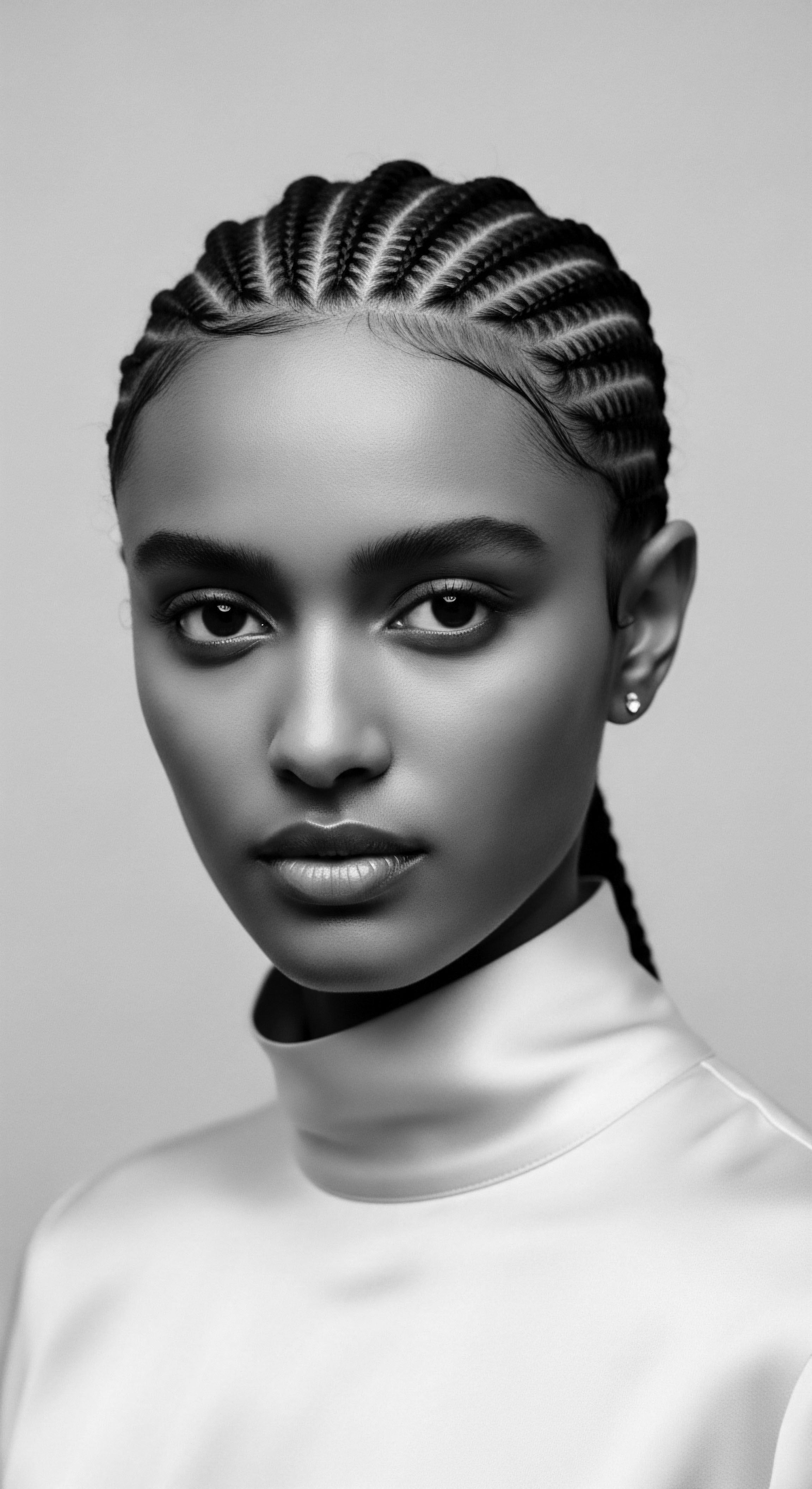
Hair Anatomy and Its Ancestral Understanding
Textured hair, with its unique elliptical follicle shape and varied curl patterns, possesses an inherent strength alongside a delicate nature. Its coiled structure, while beautiful, makes it prone to dryness and potential breakage if not tended with mindful practice. Ancient African communities understood these inherent characteristics with an intuitive, experiential science. They recognized that tightly coiling hair required specific approaches to maintain its vitality.
Unlike straighter hair types, textured hair’s twists and turns mean that natural oils produced by the scalp struggle to travel down the entire strand, leading to dryness at the ends. The traditional care rituals surrounding cornrows directly addressed this biological reality, emphasizing moisture retention and minimal manipulation.
Traditional cornrow rituals were a science of preservation, attuned to the unique physiological needs of textured hair.
The act of braiding itself, close to the scalp, was a form of protection. It encased the delicate strands, shielding them from environmental stressors like dust, sun, and friction. This protective styling reduced daily handling, minimizing the potential for breakage that often occurs with frequent combing or styling of loose, textured hair. The creation of cornrows, therefore, was not merely a cosmetic endeavor; it was an act of biological wisdom, a method of cultivating hair health passed through generations.

Traditional Classifications of Hair and the Cornrow
Long before modern classification systems, African societies developed their own nuanced ways of describing and understanding hair textures and styles. These systems were not based on numerical patterns but on social context, spiritual significance, and practicality. The Yoruba people, for example, had a vast lexicon for hair, with terms like ‘kolese’ for cornrows, denoting a creature without legs, implying the hair’s close adherence to the scalp.
Hair was seen as sacred, a medium connecting individuals to ancestors and deities. The intricate patterns woven into cornrows could signify a woman’s marital status, fertility, or rank within the community, becoming a visual language understood by all.
This communal understanding of hair’s purpose and its physical traits stood in stark contrast to later attempts to categorize textured hair through a Eurocentric lens. Traditional knowledge centered on the hair’s response to different methods of care, its natural tendencies, and its role in conveying identity. The very act of forming cornrows required an intimate understanding of the hair’s coiled nature, how it could be sectioned and manipulated with consistent tension to form durable, aligned rows. This functional classification of hair based on its behavior under tension and its ability to hold a protective style became a cornerstone of ancestral hair practices.

Hair’s Growth Cycle and Ancestral Influences
Our hair grows in cycles, a biological rhythm of growth, transition, and rest. While no hairstyle can make hair grow faster, cornrows play a significant role in length retention. By keeping the hair tucked away, cornrows reduce the daily manipulation that often leads to breakage, allowing the hair to reach its full growth potential during the anagen (growth) phase.
This understanding, though not articulated in modern scientific terms, was deeply embedded in ancestral wisdom. Communities observed that hair kept in protective styles seemed to maintain its length more effectively.
Beyond the physical act of braiding, ancestral hair health was influenced by diet and environment. Traditional African diets, rich in nutrient-dense foods, provided the building blocks for strong hair. The use of natural oils and butters, sourced from indigenous plants, nourished the scalp and strands.
These elements, from the food consumed to the air breathed, formed a holistic environment for hair health, subtly impacting the growth cycle. The practice of cornrowing, alongside a healthy lifestyle, served as a foundational ritual for fostering length and vitality.
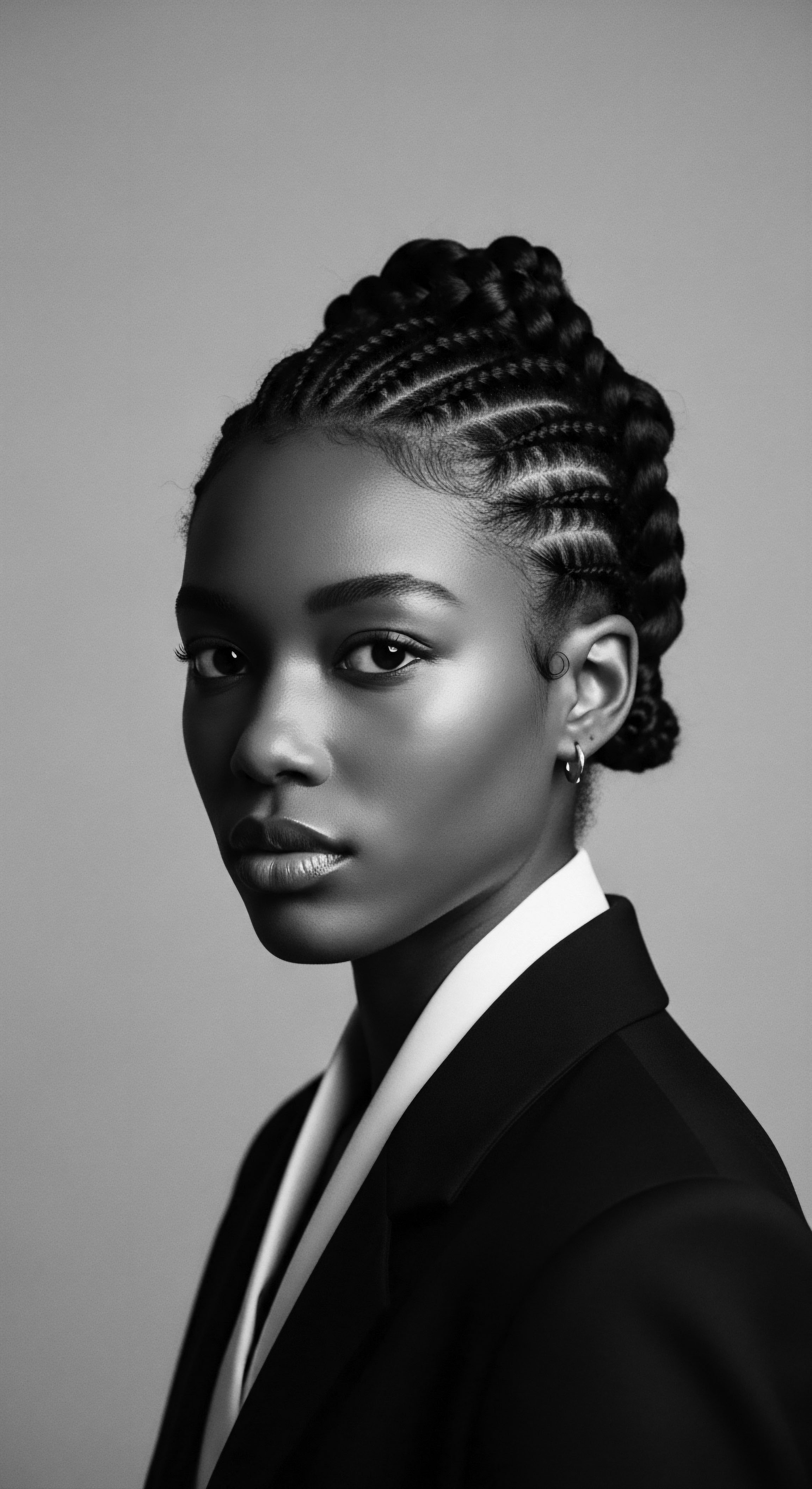
Ritual
The braiding of cornrows was rarely a solitary pursuit. It was, and in many places remains, a communal affair, a quiet symphony of hands moving with purpose, a space where stories were shared, wisdom imparted, and bonds fortified. These sessions extended beyond mere hairstyling; they were living rituals, connecting individuals to their lineage and communities.
The sustained practice of creating and maintaining cornrows, honed over millennia, stands as a testament to the ingenuity and aesthetic sensibilities of African peoples. Each row laid flat to the scalp, each curve or angle, conveyed messages as clear as spoken words.
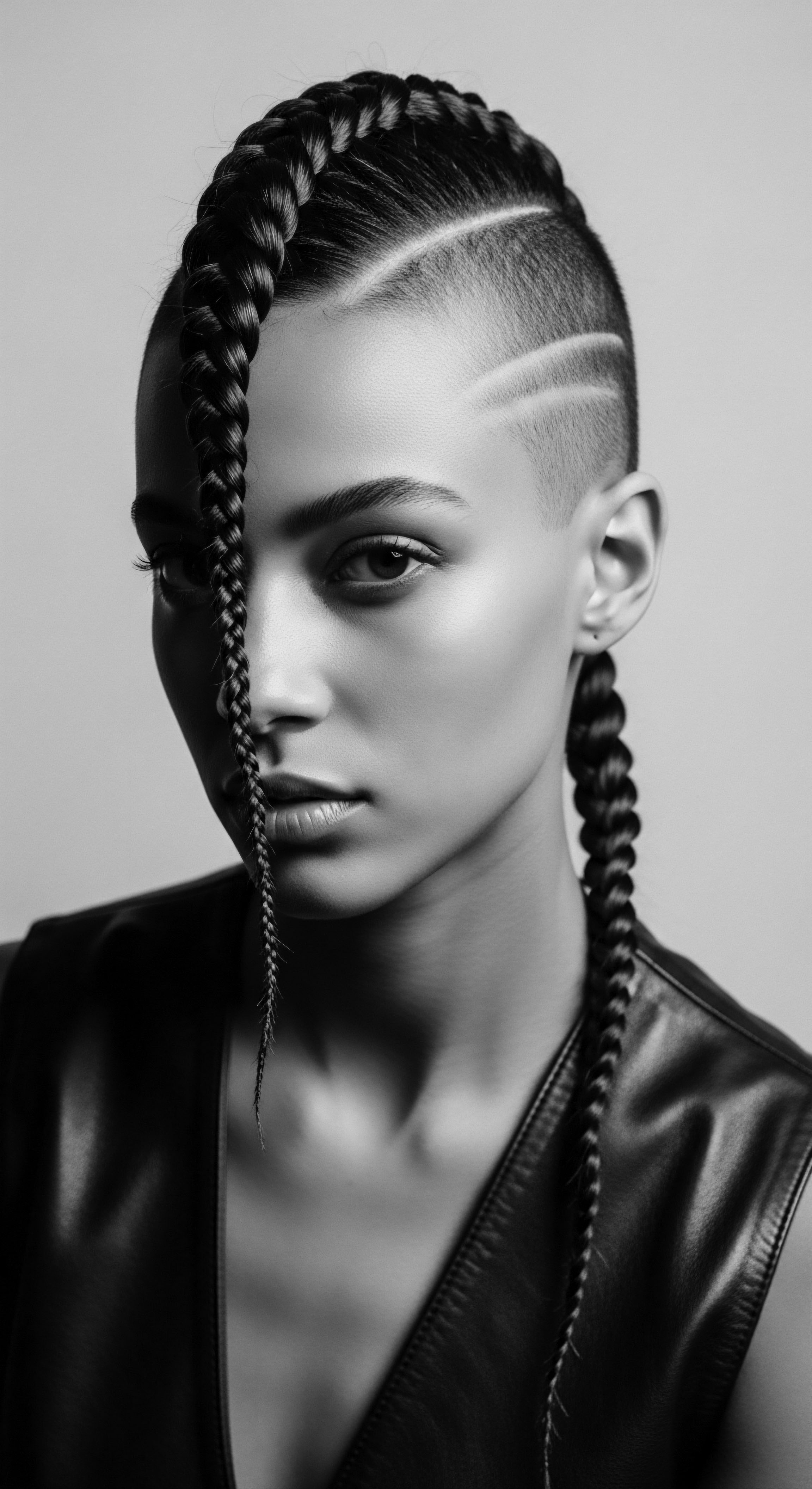
Techniques and Their Historical Echoes
The foundational technique of cornrowing involves braiding hair very close to the scalp, using an underhand, upward motion to create a continuous, raised row. This method ensures the braids lie flat and secure, minimizing friction and tangling. Historically, the precision of parting and the consistency of tension were not merely aesthetic choices; they were crucial for the longevity of the style and the health of the scalp.
The patterns could range from simple, straight lines, resembling rows of corn fields, to complex geometric designs, zigzags, and curvilinear forms. These patterns often held symbolic meaning, communicating tribal affiliation, social status, or even spiritual beliefs.
In pre-colonial Africa, hair was a visual language. For instance, certain designs might signify a person’s age group, whether they were of marriageable age, or even if they were in mourning. Skilled braiders, often revered women within the community, were not just stylists; they were keepers of tradition, their hands narrating ancestral stories through hair. The time spent in these braiding sessions, sometimes hours long, transformed the act into a ceremony, a shared experience that reinforced social cohesion and passed cultural knowledge from elder to youth.
Cornrow creation was a communal, symbolic act, transcending mere hairstyling to transmit cultural identity.
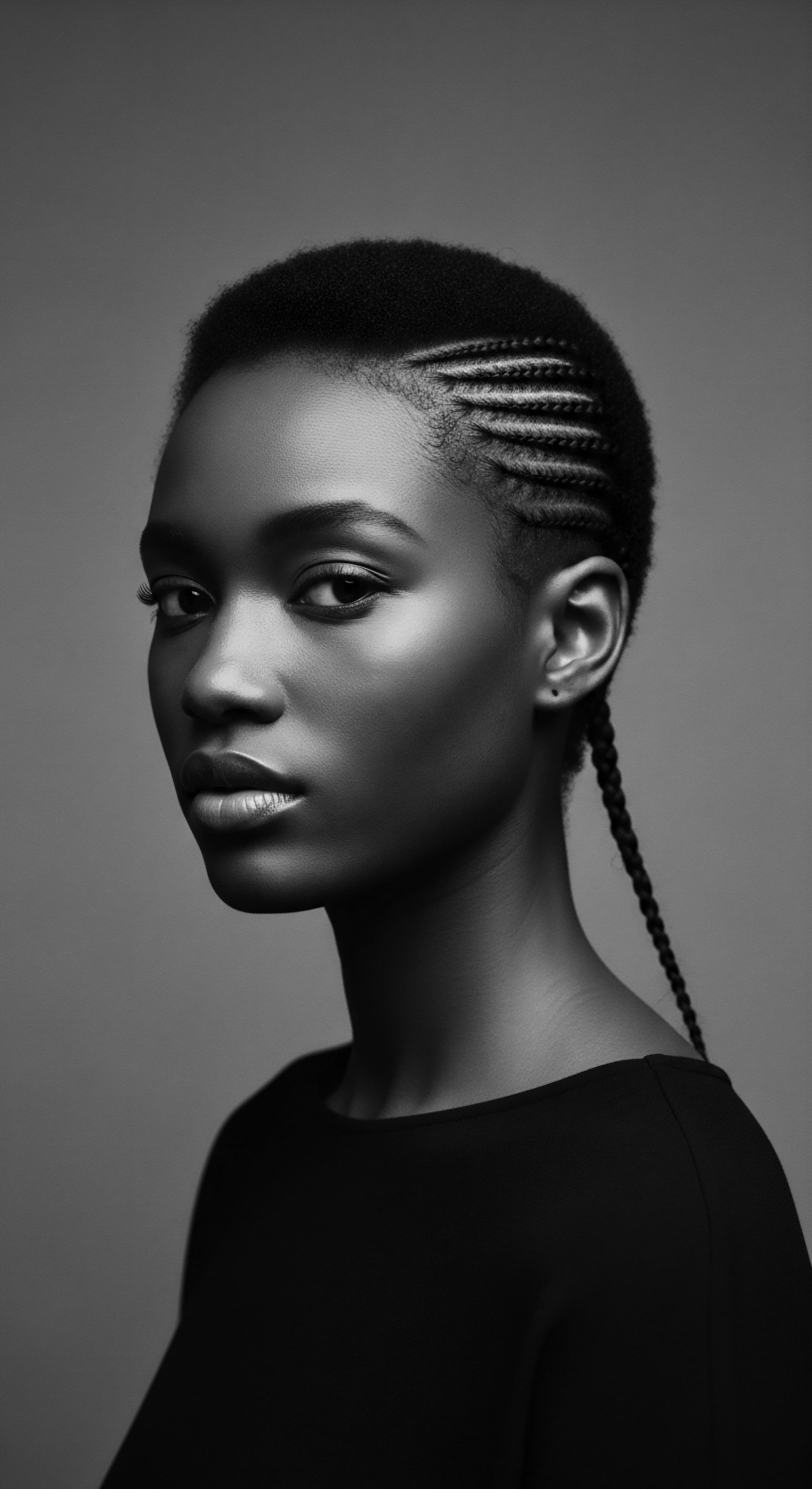
Ancestral Tools for Cornrowing
The tools used in traditional cornrowing were simple yet highly effective, often crafted from natural materials readily available in the environment. These implements were extensions of the braider’s hands, designed to assist in creating the precise lines and uniform tension that characterize cornrows.
- Ilarun ❉ Among the Yoruba people, the ‘ilarun’ was a traditional three-tailed wooden comb used for parting and detangling hair. These combs, often hand-carved, exemplify the thoughtful design that went into even the simplest tools, ensuring both effectiveness and gentleness on the hair and scalp. Their smooth finish and sturdy construction allowed for clean sections, vital for neat cornrow patterns.
- Fingers ❉ Before specialized tools, the most fundamental implements were the braider’s own fingers. The dexterity and touch developed over generations allowed for intricate parting and the meticulous creation of rows. The tactile connection between braider and subject also served to deepen the communal aspect of the ritual.
- Natural Oils and Butters ❉ While not tools in the conventional sense, various natural oils and butters were integral to the braiding process. Shea butter, coconut oil, and other plant-based emollients were applied to lubricate the hair, add moisture, and ensure a smooth glide of the fingers during braiding. They prepared the hair, making it more pliable and reducing friction.
These tools, used with practiced skill, were not just for creating a hairstyle; they were part of a holistic approach to hair wellness, ensuring the process itself contributed to the hair’s health.

Cornrows as Protective Styling and Cultural Resistance
Cornrows have long been recognized as a protective style, minimizing manipulation and exposure to environmental elements, thereby reducing breakage and promoting length retention. This practical function made them ideal for daily life in varied climates, keeping hair neat and manageable. But their significance deepened dramatically during the transatlantic slave trade. Stripped of their identities, enslaved Africans used cornrows as a powerful, silent act of resistance and cultural preservation.
Consider the remarkable historical example of enslaved Africans in Colombia. Benkos Biohó, a royal captured from the Bissagos Islands, escaped slavery and established a Palenque village. He devised an intelligence network where women braided “maps” of escape routes into their cornrows. These intricate patterns, disguised as mere hairstyles, became vital conduits of information, guiding others to freedom.
Seeds and even gold fragments were hidden within the braids, providing sustenance and resources for those escaping bondage. This transformation of a beauty practice into a tool for survival is a profound illustration of the ingenuity and resilience of African heritage. The resilience of cornrow braids, even in the face of brutal oppression, speaks to their enduring cultural significance.
| Aspect of Care Scalp Preparation |
| Ancestral Practice (Historical Context) Application of natural plant oils and butters for lubrication and suppleness before braiding. |
| Contemporary Link (Heritage in Practice) Pre-braiding shampoos and deep conditioning treatments to cleanse and moisturize, followed by lightweight oils or leave-in conditioners. |
| Aspect of Care Braiding Technique |
| Ancestral Practice (Historical Context) Underhand method, tight to the scalp, often with shared community sessions, using fingers or traditional combs like 'ilarun' for precise parts. |
| Contemporary Link (Heritage in Practice) Similar underhand braiding, with focus on consistent tension to avoid pulling, utilizing fine-tooth combs for clean parts. |
| Aspect of Care Maintenance While Braided |
| Ancestral Practice (Historical Context) Infrequent washing, reliance on natural elements and specific local herbs for cleanliness and scent. |
| Contemporary Link (Heritage in Practice) Regular cleansing with diluted, sulfate-free shampoos, moisturizing with lightweight oils/sprays to prevent dryness and itchiness. |
| Aspect of Care Longevity and Health |
| Ancestral Practice (Historical Context) Hair was seen as a living entity, its care deeply connected to spiritual and social well-being; braids were kept for extended periods reflecting their protective nature. |
| Contemporary Link (Heritage in Practice) Recommended wear time of 2-8 weeks to prevent buildup, matting, or potential traction alopecia from excessive tension. |
| Aspect of Care The continuum of cornrow care, from ancient community wisdom to modern practices, mirrors a deep, abiding respect for hair as a cultural and physical asset. |

Relay
The wisdom of textured hair care, particularly concerning styles like cornrows, has been relayed across generations, adapting to new environments while holding fast to its ancestral core. This ongoing transmission is not just about techniques; it is a holistic philosophy, recognizing hair as integral to overall wellness and identity. The regimen of radiance for cornrows, whether practiced in ancient villages or contemporary homes, finds its roots in practices that speak to deep nourishment and deliberate preservation.
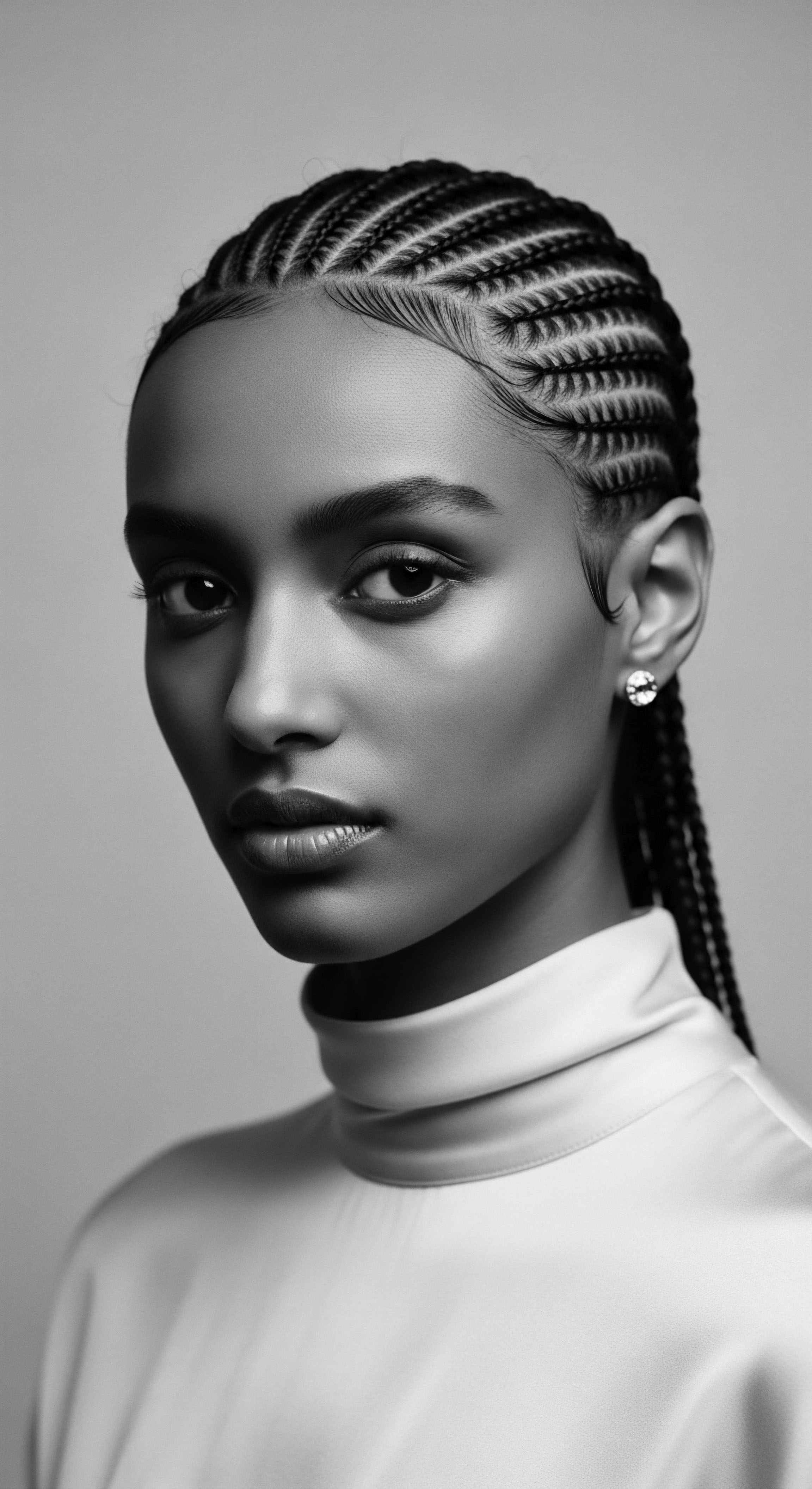
Building Personalized Textured Hair Regimens from Ancestry
Ancestral hair care was inherently personalized, though not in the individualized product sense of today. It was personalized by climate, local flora, and communal wisdom. Families and tribes developed their own regimens, often passed down through matriarchal lines, that accounted for the specific needs of their hair textures within their environment. The principles, however, shared common threads ❉ cleanliness, moisture, and protection.
Ancient African communities relied on the bounty of their surroundings. Shea butter, sourced from the shea tree, served as a foundational emollient, providing intense moisture and sealing properties. Coconut oil, widely available in coastal regions, was another staple, known for its ability to penetrate the hair shaft and condition from within. These ingredients were not randomly chosen; their properties were observed and applied through generations of trial and lived experience.
The concept of “sealing in moisture,” a modern hair care term, finds its practical heritage in the application of these rich butters and oils after cleansing with natural clays or plant extracts. The traditional regimen for cornrows often involved:
- Cleansing with Naturals ❉ Instead of harsh sulfates, historical cleansing involved water and natural plant-based cleansers, sometimes using clays or herbs with saponifying properties to remove impurities gently. This ensured the scalp remained balanced and hair was not stripped of its natural oils.
- Conditioning and Detangling ❉ Botanical extracts and softened plant butters served as conditioners, aiding in detangling the tightly coiled hair before braiding. The gentle process of finger-detangling or using wide-tooth wooden combs was also key.
- Lubrication for Braiding ❉ As discussed, oils and butters were applied during the braiding process to reduce friction, add shine, and make the hair more pliable for precise parting and plaiting.
- Post-Braiding Nourishment ❉ Even after cornrows were installed, the scalp and visible hair were regularly moisturized with lighter oils or herbal infusions to maintain hydration and prevent itching, extending the style’s life.
This ancestral blueprint offers timeless lessons. It emphasizes listening to the hair’s needs, using natural ingredients, and prioritizing methods that minimize manipulation while maximizing moisture retention.

The Nighttime Sanctuary ❉ Bonnet Wisdom and Sleep Protection
The ritual of protecting hair during sleep is not a modern innovation; it is a practice deeply rooted in ancestral wisdom, refined over centuries to preserve textured hair. For cornrows, which are designed to last for weeks, nighttime protection is crucial for maintaining their structure and preventing frizz and dryness.
Historically, various forms of head coverings, from simple cloths to elaborately wrapped turbans, served this purpose. These coverings, often made from natural fibers, protected the hair from friction against rough sleeping surfaces and helped to seal in the moisture applied during daytime rituals. The bonnet, as we know it today, is a direct descendent of these ancestral practices, offering a smooth, non-abrasive surface, traditionally silk or satin, that safeguards the hair’s integrity.
This protective layer reduces tangling, preserves the neatness of the cornrows, and minimizes moisture loss, allowing the style to last longer and the hair beneath to thrive. The consistency of this nighttime ritual is a quiet, powerful act of care, a continuation of a lineage of self-preservation.
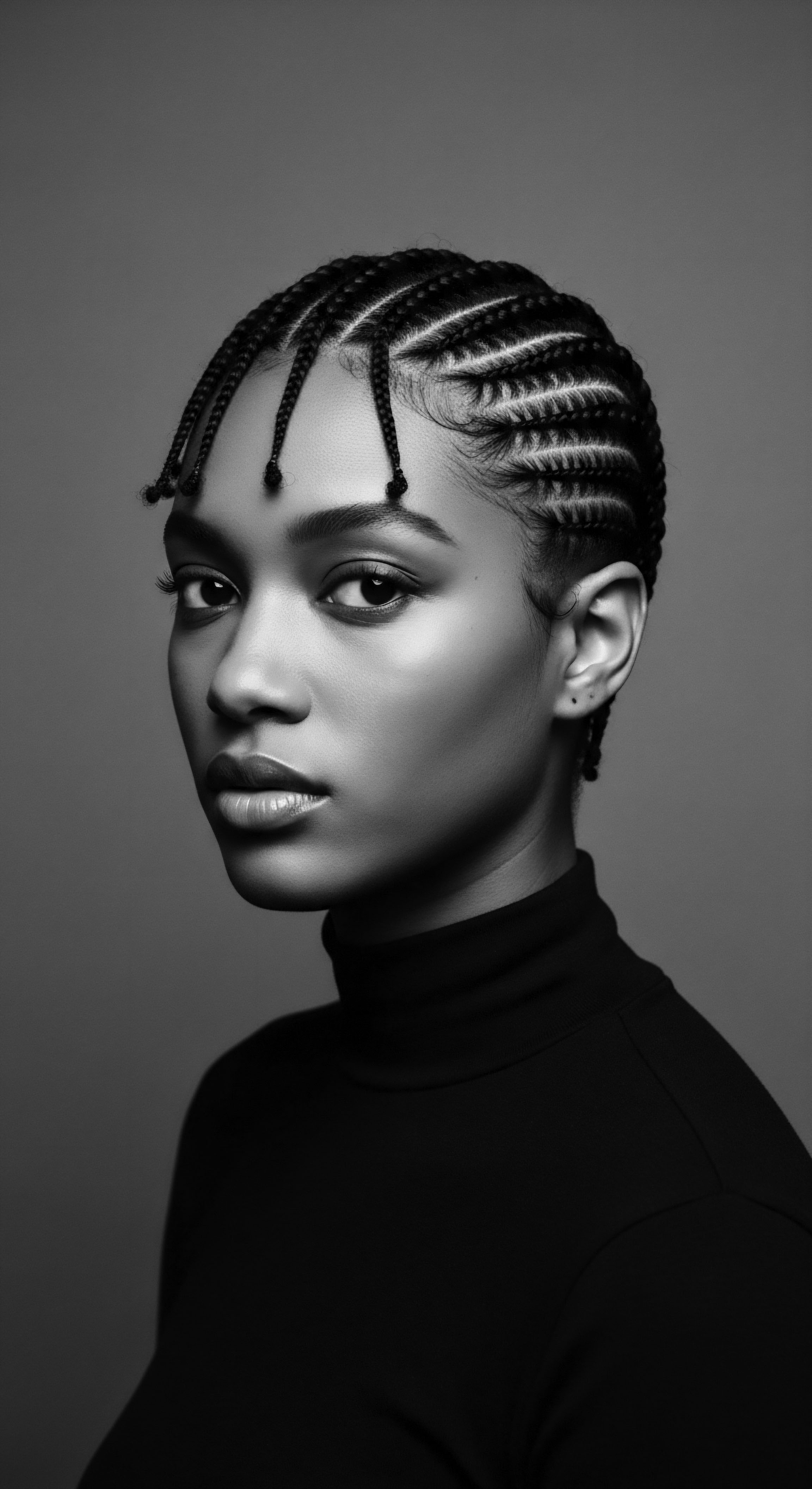
Ingredient Deep Dives for Textured Hair Needs
The effectiveness of ancestral hair care is grounded in a profound understanding of natural ingredients. For cornrow maintenance, specific plant-derived elements were favored for their restorative properties:
- Shea Butter ❉ Known for its rich emollients, shea butter forms a protective barrier on the hair shaft, locking in moisture and shielding it from external aggressors. Its anti-inflammatory properties also helped soothe the scalp, particularly important after the tension of braiding.
- Coconut Oil ❉ This widely available oil, rich in lauric acid, can penetrate the hair shaft, reducing protein loss and providing deep conditioning. It was often used for its softening effects and to add a natural sheen to braided styles.
- Aloe Vera ❉ Used for its soothing and hydrating properties, aloe vera was applied to the scalp to alleviate itchiness and inflammation, common concerns with protective styles. Its gel-like consistency also provided a light hold and freshness.
- Chebe Powder ❉ Hailing from Chad, this blend of herbs (including lavender crotons, stone scent, and cherry seeds) is traditionally used by the Basara women for extreme length retention. When mixed with oils and applied to the hair, it creates a lubricating effect that prevents breakage, a significant aid in maintaining the integrity of cornrows over time.
- Marula Oil ❉ A traditional oil from Mozambique and South Africa, marula oil is celebrated for its hydrating properties and light texture, making it an ideal choice for scalp lubrication without heavy residue.
These ingredients represent a living pharmacy, their benefits validated by centuries of successful use and increasingly, by modern scientific inquiry. Their application within cornrow care ensured the hair and scalp remained balanced, nourished, and resilient.

Cornrow Care and Problem Solving
Even with the most careful application and the best intentions, textured hair in cornrows can experience certain challenges. Ancestral knowledge, however, provided solutions often echoed in contemporary recommendations.

Addressing Tension and Scalp Sensitivity
One common concern with cornrows is the potential for tension at the scalp, which if excessive, can lead to discomfort or even a condition known as traction alopecia, where continuous pulling on hair follicles results in hair loss. Ancestrally, skilled braiders understood the balance between a secure braid and undue stress. They would ensure tension was consistent yet not overly tight, especially around the delicate hairline.
When discomfort arose, traditional remedies focused on soothing the scalp. Herbal infusions, often containing anti-inflammatory properties, were gently massaged onto the scalp to relieve irritation. Oils like peppermint or tea tree (though perhaps not in their exact contemporary forms, but certainly plant equivalents with similar properties) were used for their cooling and antiseptic qualities.
These practices underscored a philosophy that prioritizes scalp health as the foundation for healthy hair, a principle still central to modern cornrow care. Regular, gentle moisturizing of the scalp with lightweight oils is a recommended modern practice to prevent dryness and itchiness, mirroring these ancient soothing rituals.

Moisture Retention and Cleansing Approaches
Maintaining moisture is paramount for textured hair in cornrows, as dryness can lead to frizz and breakage. Ancestral practices utilized natural oils and butters liberally to seal in hydration. The Basara women’s Chebe mixture, for example, is applied to hair and braided to maintain moisture and length, demonstrating a clear ancestral link to this practice.
For cleansing cornrows, traditional methods often involved lighter, water-based rinses or diluted plant-based concoctions to avoid disturbing the braids and causing frizz. Modern advice aligns with this, suggesting diluted, sulfate-free shampoos applied directly to the scalp, followed by thorough rinsing. The goal remains the same ❉ to keep the scalp clean without undoing the style or stripping the hair of its vital moisture. This considered approach to cleansing ensures the longevity of the style while maintaining scalp hygiene.

Relay
The enduring legacy of cornrow heritage is not merely a historical footnote; it is a living, breathing continuity, a vibrant thread connecting ancestral wisdom to contemporary expressions of beauty and wellness. The complex interplay of social, cultural, and biological factors that shaped traditional cornrow care continues to inform and inspire the practices of today. This relay of knowledge speaks to the resilience of textured hair and the communities that celebrate it, underscoring how these rituals transcend mere aesthetics to embody identity and self-affirmation.
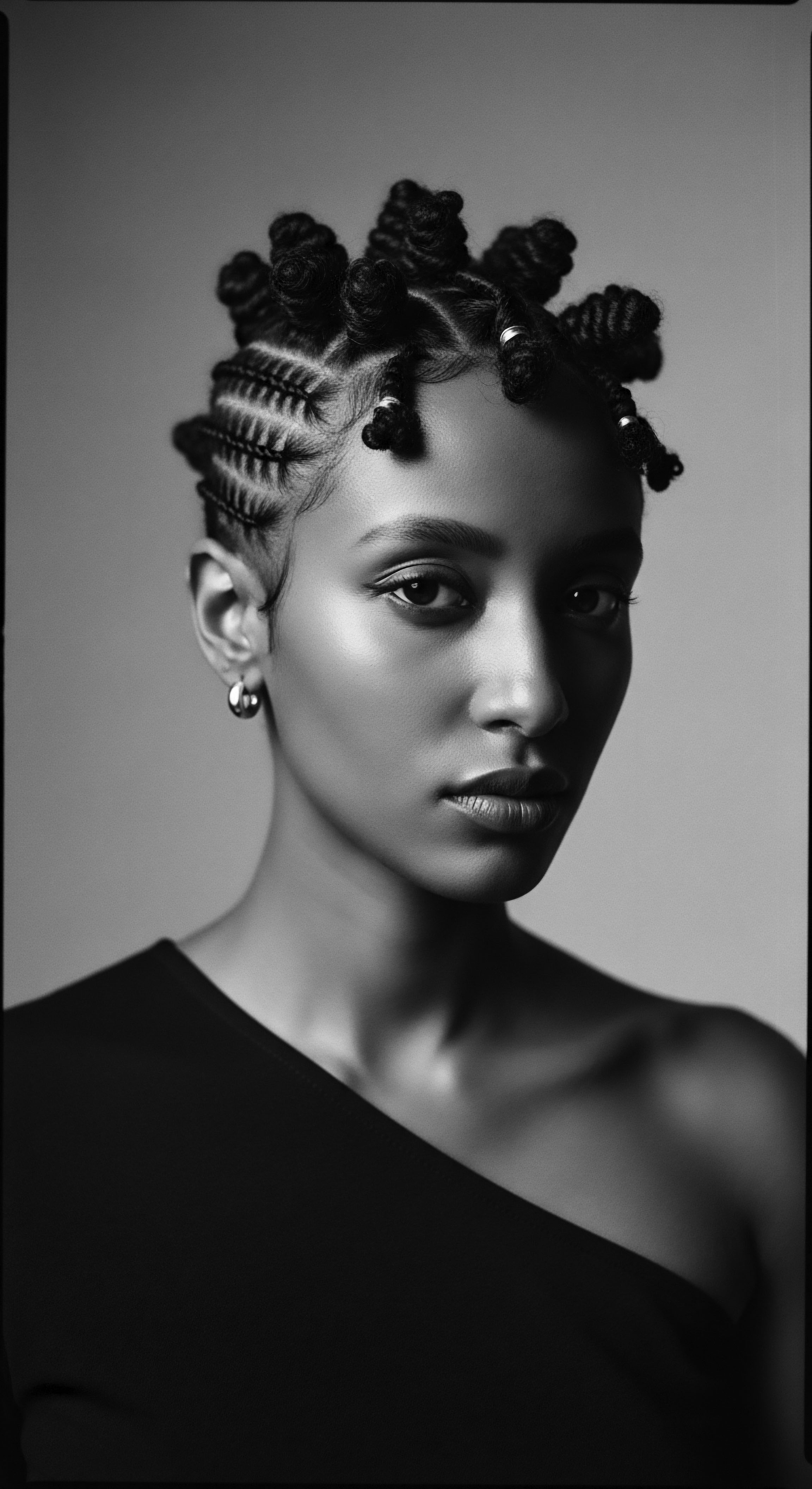
The Sacred Act of Braiding ❉ A Historical Case Study of Resistance
To comprehend the depth of cornrow heritage, one must consider its role during periods of extreme adversity. The transatlantic slave trade, a brutal era that forcibly displaced millions of Africans, sought to strip enslaved people of their cultural identity, often beginning with the violent shaving of their heads. Despite this dehumanizing act, the art of cornrowing persisted, transforming into an extraordinary act of resistance and cultural preservation.
A poignant and powerful example comes from the narratives of enslaved Africans in Colombia. As documented, Benkos Biohó, an enslaved leader who escaped and established a free community known as San Basilio de Palenque, utilized cornrows as a covert communication system. Women meticulously braided maps of escape routes into their hair, the intricate patterns guiding others to freedom. Beyond directional maps, these braids also concealed gold fragments and seeds, offering vital nourishment and resources for those embarking on perilous journeys to liberty.
This practice, transforming a styling ritual into a sophisticated intelligence network, is a compelling illustration of how traditional care rituals were intrinsically linked to survival and the assertion of human dignity. It reveals a profound level of ingenuity, where knowledge of hair’s manageability was ingeniously applied to safeguard life and heritage. This historical context illuminates how traditional cornrow care, born of necessity and deep cultural roots, became a powerful, silent language of defiance, a testament to the indomitable spirit of those who wore them. (Byrdie, 2022)

Cultural Continuity Through Shared Practices
The communal nature of hair braiding sessions, so prevalent in pre-colonial Africa, sustained itself through the diaspora. These gatherings, whether in hidden corners of plantations or later in communal spaces, allowed for the continuous transfer of techniques and cultural narratives. The act of braiding became a shared language, solidifying bonds and fostering a collective sense of self in the face of fragmentation. Elders patiently guided younger hands through the delicate process of sectioning, plaiting, and sealing, ensuring that the wisdom of generations was not lost.
This transmission of knowledge wasn’t academic; it was embodied, felt through the rhythmic pulling of hair and the familiar scent of natural oils. The continuity of these rituals solidified cornrows as more than just a style; they were a symbol of community, heritage, and strength. Even today, for many Black and mixed-race individuals, a cornrowing session with a family member or trusted stylist serves as a conduit to this enduring legacy, a reaffirmation of their place within a vibrant cultural lineage.

The Scientific Validation of Ancestral Wisdom
Modern hair science increasingly offers explanations that affirm the efficacy of traditional cornrow care rituals. The protective nature of cornrows, for instance, aligns with scientific understanding of minimizing mechanical stress on textured hair.
Textured hair, due to its coily morphology, possesses more points along the strand where it can break if subjected to constant manipulation or environmental friction. By securing the hair in cornrows, daily combing, brushing, and styling are significantly reduced, thereby mitigating breakage. This allows for length retention, giving the impression of accelerated growth, though the underlying biological growth rate remains constant.
Modern hair science confirms the protective power of cornrows, validating ancestral care practices that preserved hair length.
The traditional use of natural oils and butters for scalp and hair nourishment also finds support in contemporary trichology. Ingredients like shea butter create an occlusive layer that minimizes transepidermal water loss from the scalp and forms a protective film on the hair shaft, preventing moisture evaporation. Coconut oil, with its unique molecular structure, has been shown to penetrate the hair cuticle, reducing protein loss and providing internal conditioning, leading to greater hair resilience.
The application of these ingredients during and after cornrow installation contributed directly to the health and integrity of the hair and scalp, preventing common issues like dryness and flaking. The ancestral practice of applying these elements to the scalp and hair, often massaged in, stimulated blood flow and ensured even distribution, a method that modern hair care routines continue to advocate.
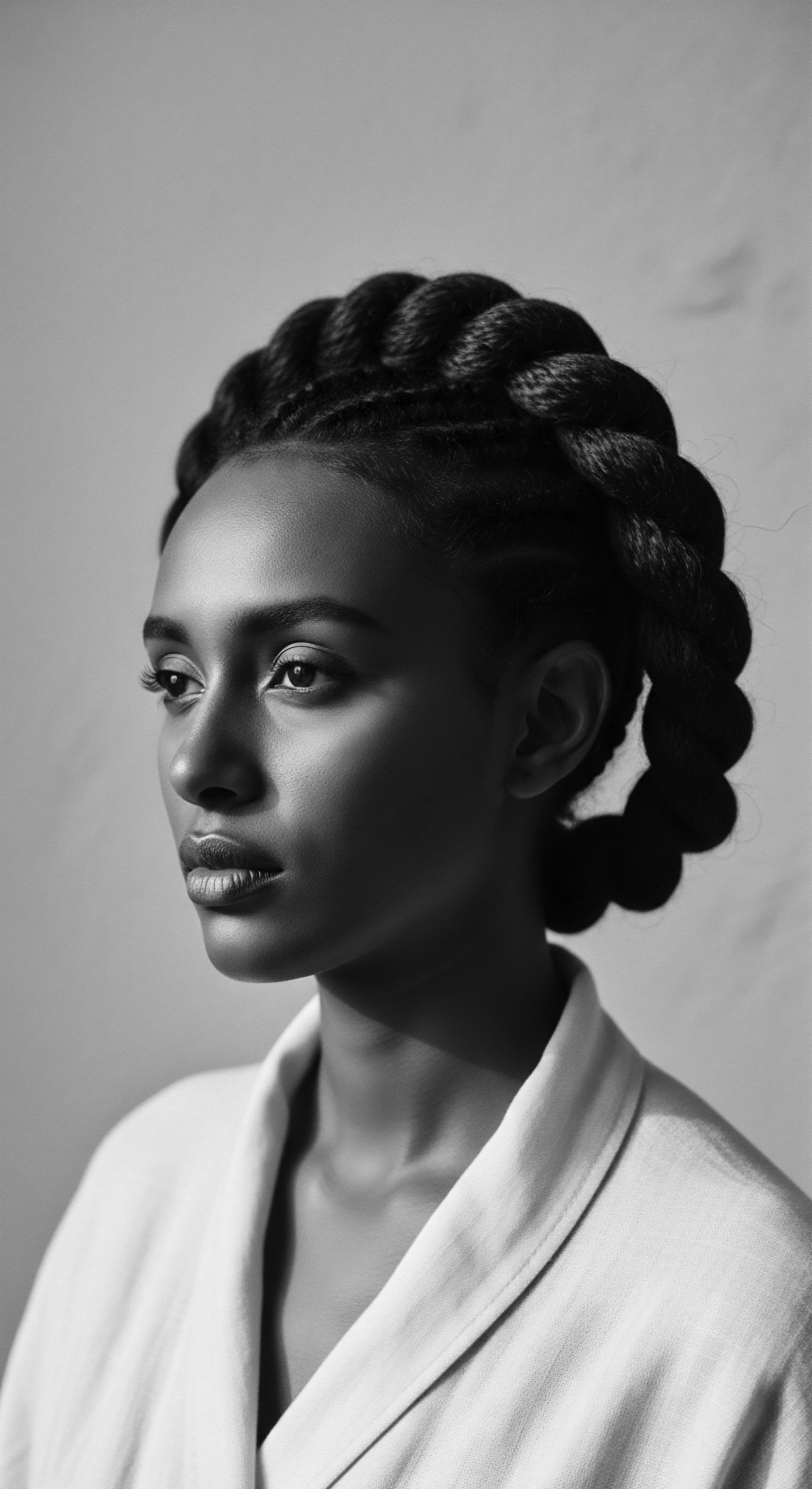
The Resilience of Hair and Spirit
The journey of cornrow heritage from ancient African civilizations through the transatlantic slave trade and into contemporary society is a compelling testament to the resilience of textured hair and the spirit of those who wear it. Despite attempts to erase cultural practices, cornrows persisted, adapted, and continued to communicate deep meaning. This enduring presence speaks to the profound connection between hair, identity, and collective memory within Black and mixed-race communities. The practice of cornrowing today, whether for protective purposes, artistic expression, or cultural affirmation, is a direct continuation of these ancestral legacies.
It is a daily, sometimes weekly, ritual that grounds individuals in their heritage, celebrating the very fabric of their being. The physical act of braiding, the shared experience, and the visual statement of pride all coalesce into a living archive of resistance and beauty.
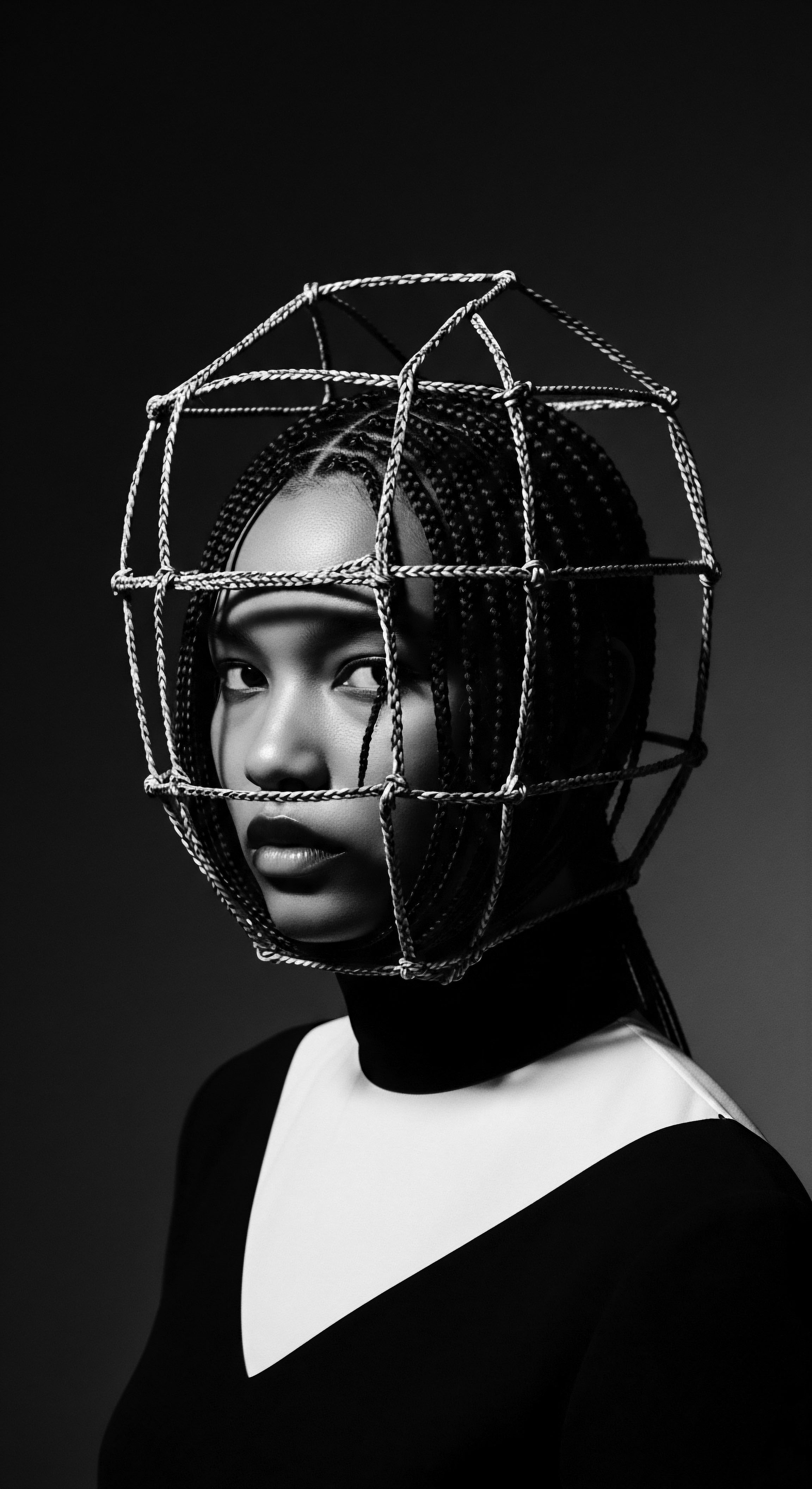
Reflection
The exploration of cornrow heritage brings us to a profound understanding ❉ the story of textured hair is an unfolding saga of memory, resilience, and unwavering spirit. Every twist and turn of a coiled strand, every precisely crafted row, holds within it the whispers of ancestors, the echoes of ingenuity, and the quiet triumphs of a people who have consistently found ways to celebrate their true selves. This is the very Soul of a Strand—not just an anatomical marvel, but a living repository of human experience.
The traditional care rituals linked to cornrows are more than prescriptive steps; they are expressions of a worldview that values hair as a sacred extension of self and a vital link to community. From the ancient understanding of hair’s biology to the resourceful adaptation of styling during periods of profound challenge, these practices highlight an enduring connection to heritage. They remind us that true wellness for textured hair stems from a holistic approach, one that honors the wisdom passed down through generations, recognizing the deep efficacy of natural ingredients and the power of communal care.
As cornrows continue to shape futures, gracing runways, informing pop culture, and affirming identity in everyday life, their legacy serves as a beacon. It is a powerful reminder that the most authentic forms of beauty care are often those rooted in time-honored traditions, those that recognize the intricate relationship between physical well-being, cultural identity, and ancestral memory. The journey of cornrows is a continuing testament to the beautiful, unbroken lineage of textured hair, a heritage always alive, always evolving, and always guiding us back to the source.
References
- Ajao, T. (2022). Black History Month 2022 ❉ The History Behind Cornrows. Beds SU.
- BarberSets. (2023). Cornrows ❉ History, Culture, and Contemporary Styles.
- Byrdie. (2022). The Beautiful, Black History of Cornrows.
- Doria Adoukè. (2023). Unveiling the Rich History and Origins of Cornrows.
- Fix Salon. (2024). Celebrating Diversity ❉ Cultural Influences on Hair.
- JALIZA. The Enduring Legacy of Cornrow Braids ❉ A Journey from Ancient Roots to Modern Expression.
- JALIZA. Essential Care for Cornrow Braids ❉ Maintaining Health and Style.
- JALIZA. Preserving Edges and Embracing Heritage ❉ The Impact of Cornrow Braids on Hairline Health.
- JALIZA. Cornrows and the Myth of Texture Change ❉ Unraveling the Truth Behind Braided Illusions.
- Lemon8. (2025). How to Achieve Perfect Cornrows ❉ A Guide to Braided Hairstyles.
- Pan-African. (2021). A Celebration of Cornrows.
- Prose. (2021). A Complete Guide to Protective Styles.
- Royaltee Magazine. (2021). Braids, Plaits, Locs ❉ The History of Black Protective Hairstyles.
- Student Spotlights. (2025). Cornrows ❉ A Timeless Hairstyle With Cultural Significance.
- WebMD. (2011). 8 Ways You’re Damaging Your Hair.
